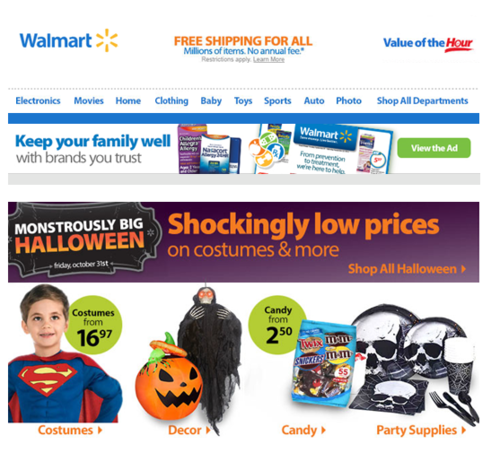Here is a recap of what happened in the search forums today...
Tuesday, September 30, 2014
Key Takeways: OTA Academy's 2014 Email Unsubscribe Best Practices and Audit Webinar

Today the Online Trust Alliance Academy presented 2014 Email Unsubscribe Best Practices and Audit. During the hour-long webinar, OTA Exeuctive Director Craig Spiezle was joined by Listrak Chief Privacy Officer James Koons and Innovyx CEO Derek Harding to talk about unsubscribe best practices beyond CAN SPAM and CASL compliance, as well as the results of OTA’s audit of the unsubscribe practices of leading eCommerce merchants.
Below is some of the information that was shared:
- It’s been 10 years since CAN-SPAM went into effect.
- CAN-SPAM is the minimum required. The goal is to surpass CAN-SPAM and adopt unsubscribe best practices.
- Unsubscribe practices and regulations are an international issue, so there is more to consider than CAN-SPAM and CASL.
- Opt-out links must be clear and conspicuous and visible from the last sentence of an email. They can’t be buried in copy.
- Unsubscribe links must be readable both in terms of color and font size.
- Senders must provide an easy opt-out for all email, not just the specific email program the recipient has clicked on.
- Use a link directing users to a combination preference center to unsubscribe, opt down or make other changes.
- It is an unsubscribe best practice to eliminate confusion by branding the unsubscription landing page.
- Serve an unsubscribe confirmation web page, not a confirmation email.
- On the unsubscribe page, the sender can include a link to resubscribe or link to a preference center.
- Although CAN-SPAM and CASL permit senders up to 10 days to remove an unsubscribe, it is a best practice to remove the address and add it to the suppression list immediately.
- Senders must comply with the regulations of where the recipient resides (or is opening the email), not where the sender is located.
- It is a best practice to adopt a list-unsubscribe mechanism within the header of each message.
- While the sender may not make completing a survey a requirement of unsubscribing, including a survey is a best practice to provide a more positive experience.
- Results of the 2013 Unsubscribe audit reveal that 10% of the largest eCommerce brands are not in CAN-SPAM/CASL compliance.
- The audit also showed that many of the largest eCommerce brands do implement best practices, however, the outliers overshadow the industry.
- Nearly 70% of the brands in the unsubscribe audit scored 80% or better on their use of the top 10 unsubscribe best practices.
- It is imperative that senders test their unsubscribe practices on a regular basis both to ensure that they’re effective and that they’re compliant.
To read the OTA 2014 Unsubscribe Audit report, visit https://otalliance.org/news-events/press-releases/unsubscribe-best-practices-moving-stewardship.
Client Meetings: Separating Fear From Reality
Feed Your Leads, Don’t Starve Your Business
6 Ways Social Proof Can Increase Conversions On Your Site
In February 2004, Facebook was a small and unknown website, used only by Harvard students. By summer, they had expanded to other Ivy Leagues, but they were still pretty small. Typically, VCs don’t invest in companies that are so small and have no idea how they’re going to make money. Watch Shark Tank or Dragon’s [...]
The post 6 Ways Social Proof Can Increase Conversions On Your Site appeared first on The Daily Egg.
'Un-link' Building: How To Successfully Remove Penguin Links
Lost your rankings in Google? Built some dodgy links in the past that you're now worried about? Been a victim of a competitor attack? Google's Penguin update, first released in April 2012 changed the face of link building as we knew it. Prior to that, sites linking to yours did little harm, at least not [...]
Post from: Search Engine People SEO Blog
'Un-link' Building: How To Successfully Remove Penguin Links
--
Written by Barrie Smith, Receptional blog
The post 'Un-link' Building: How To Successfully Remove Penguin Links appeared first on Search Engine People Blog.
The Top 20 Most Effective Holiday Subject Line Words [Infographic]
We analyzed 10,000 email campaigns to come up with 20 top-performing holiday subject line words
The post The Top 20 Most Effective Holiday Subject Line Words [Infographic] appeared first on VerticalResponse Blog.
Google: There Isn't A Magical SEO Advantage By Switching To HTTPS
6 Tips for Sequencing Your Marketing Content
The Myth of Google's 200 Ranking Factors
Posted by gfiorelli1
The woman in the gif below just said to Captain Picard that she can show him the definitive and complete list of the 200 Google ranking factors.
Picard, who is a wise man, can do nothing but going away with a facepalm.
Who can blame Captain Picard for his reaction? We all know, in fact, that a complete and ultimate list of the 200 ranking factors does not exist.
If you agree, then why do we still see statistics like these below on Buzzsumo?

Let me offer this disclaimer before I continue:
I am not writing this post to attack people like Brian Dean, who, in August, published an update to the "complete list" that Backlinko first presented in 2013. Brian, whom I esteem, created an effective piece of link bait (as the 318 linking root domains it earned testify).
I am writing this post because those lists are, quite simply, useless and dangerous, and because I hope to help people—especially the newer generations of SEO—understand that a definitive and complete "List" of Google's ranking factors does not exist. Moreover, some of the factors that appear in those lists:
- Are myths;
- Are correlation factors and not causal factors;
- Are presented just to reach the number of 200.

The origin of the myth
I admit that I did not know how the myth of "200 Google Ranking Factors" was created, but a good SEO pal of mine, Giorgio Taverniti, revealed it to me.
The first time Google declared it was using 200 ranking factors was in its Press Day on May 10th, 2006 (you may also want to read the live blog Matt Cutts did, as it illuminates many things that happened thereafter).

Seeing that the correct phrasing was "over 200 ranking factors," we can say that "200" was an approximated number, perhaps offered to journalists in order to explain how complex Google's algorithm is. If the audience had been composed of information technologists, Alan Eustace would probably have used another wording.
Another proof of how silly it is to claim to have discovered "the 200 Google ranking factors" is that, in 2010, Matt Cutts himself declared that, yes, Google counts on over 200 rankings factors, but that each factor may have up to 50 variations:

Meaning is important
Are you sure you really know what "ranking" and "indexing" mean?
I ask you this because I know many SEOs who use both words as synonyms, when they are two completely different concepts and stages of how a search engine works.
Indexing is one of the four interconnected and interdependent phases of how a search engine works:
- Crawling
- Parsing
- Indexing
- Search
Indexing is the process of locating and mapping resources around the web that are associated with a word or phrase, and it is something the search engines do, not SEOs, even if SEOs can help their work optimizing a site.
The index, as was so effectively explained to me by Enrico Altavilla, is used to determine what resources to suggest as an answer to a query and the words/phrases composing it, not in what order to suggest them. That is the function of the ranking phase.
Ranking is the final moment of the fourth phase: Search.

Context plays a major role in the Search phase, and almost every step takes into account the user's and device's characteristics.
As we can see from the image above, the Search phase is composed of four distinct stages:
- Understanding the input given by the user with a query. Hummingbird very likely operates in this moment, because Google, in order to understand better the input, modifies or extends the query and just after moves to the second stage;
- Retrieving documents from the Index, taking into account commands like "noindex."
- Filtering & clustering. Once Google has understood the input and retrieved the corresponding documents from the Index, it applies filters like Panda and others spam filters, but also less considered ones as the Safe-Search filter and the often forgotten Private Search layer (personalization).
- Ranking. Google applies in this moment the X number of ranking factors, not before. And the ranking factors should be considered and counted for every kind of index Google has:
- Universal search
- Image search
- Local search
- etc.
We should not forget, then, that content and layout composing the SERPs depend a lot on things like the device used.

The Unbearable Lightness of SEOs
SEOs are talented professionals with a natural tendency to develop a manic-depressive psyche.
Ok, I have exaggerated a little bit, but—and I am an SEO, too—we live moments of pure joy when we see that our work is making the organic traffic of a site rise up and to the right, but also sudden dark periods of (unconscious?) anxiety when Google announces an update or we see a small traffic drop.
For that reason, we love ranking factor lists.
We need them not just as a potential source of information, but because they reassure us, too.
And we love them even if they are just a sequence of myths.
Let's take, for example, " Google's 200 Ranking Factors,", published by Backlinko, which I use for no other reason than it being the most recent successful list published.
I'll start with an easy one:
1 - Keyword Density [Ranking Factor 17]
My eyes bleed reading that although not as important as it once was, keyword density is still something Google uses to determine the topic of a webpage.
Keyword Density never was a Google's ranking factor. Never.
If we really want to find keyword density as factor for ranking, we must go back to the 70s and 80s and look at what Stephen E. Robertson, Karen Spärck Jones, and others described as the Okapi BM25 formula.
If keyword density ever had some relevancy as a ranking factor, it was in the Pleistocene era of search engines.
We live in 2014 and Google just had its 16th birthday.
It is still obviously important having the keyword we want to rank for in the text of a web document.
However we also know that it is also possible to make our site ranking for that keyword without having it at all in the page, if Google finds enough consistent and relevant external signals, which associate that keyword to our site.
2 - LSI [Ranking Factors 18/19]
For this example I will cite what Bill Slawski wrote in this Inbound.org thread:
Latent Semantic indexing was invented and patented in 1990, before there was a web.
It was developed to help index small (less than 10,000 documents) databases of documents that didn't change much (like the Web does).
There have been a number of companies that started selling LSI Keyword generation tools that promised that they could help identify synonyms and words with the same or similar meaning.
Where those fail is that the LSI process requires access to the database (of documents) in question to calculate which words are synonyms - and the only people with access to Google's database to do that kind of analysis (which isn't possible anyway since Google's index is much to big and changes much to frequently) is Google.
3 - YouTube [Ranking Factor 76]
There's no doubt that YouTube videos are given preferential treatment in the SERP .
How can be this a ranking factor? Eventually it is a monopolistic use Google does of its own search engine, but a ranking factor?
This is a classic example of how t hese lists tend to be everything but scientific, hence unreliable if not even dangerous.
4 - Site Uptime [Ranking Factor 69]
What Brian says is correct: if Google, despite of several attempts, see that a site returns a 500 server response, then that site will start being pushed out of the SERPs.
Correct, but in this case we are talking about an Indexing issue, not a Ranking one. As I wrote before, meaning is important.
5 - Keyword as first word in domain name [Ranking Factor 3]
The ranking factor list includes this factor because in 2011 a panel of SEOs (myself included) considered that EMDs and PMDs were clearly having an advantage in terms of rankings, and so declared it in the Moz Search Ranking Factors Survey.
In 2013 Moz published a new edition of that survey, and the opinions the same SEOs had were quite different.
The most important thing, though, is understanding that these were just opinions from SEOs; they should be considered (with all the disclaimers) possible, but based more on personal experiences.
Any opinions, although authoritative, are just opinions and not science, let alone ranking factors.
6 - Country TLD Extension [Ranking Factor 10]
It is true that cTLDs offer a stronger geo-targeting indication to Google than geo-targeted subfolders and subdomains.
However, as any international SEO can confirm, a web site with a cTLD domain termination does not necessarily rank better than a generic domain name.
What is not so true, then, is that an .es or .it web site cannot rank well outside of Google.es or Google.it. In this post I wrote last spring on State of Digital, I presented many examples where sites with "Latin American" cTLDs were outranking .es ones in Google.es. In the comments to the posts, then, you can see that this is something common in every regional version of Google.
This "ranking factor" is a clear example of how these kind of lists may mix correct information with dangerous ignorance. (I am using "ignorance" in its real meaning as "lack of knowledge or information on a given subject," in this case international SEO, and not in its pejorative sense.)
7 - Use of Google Analytics and Google Webmaster Tools [Ranking Factor 78]
How can something described this way be a ranking factor?
"Some think that having these two programs installed on your site can improve your page's indexing. They may also directly influence rank by giving Google more data to work with..."
"Some think?" Who? The university student ranting in a forum? A information technologist? An insider in Mountain View? This is purely speculation.
8 - Guest Posts [Ranking Factor 91]
When we talk about how dangerous doing some kinds of guest posting can be, we are talking about web spam.
Therefore, if a link (or a series of links) from guest posts are considered as having a manipulative nature, we should talk about "Spam Filters" (3rd Stage of Search) and not actual ranking.
Again, meaning is important.
9 - Facebook Likes and Facebook Shares [Ranking Factor 157/158]
Google cannot see likes and Facebook shares. So they cannot be a ranking factor. Period.
Matt Cutts, in the same SMX panel the list cites as its source, said:
We like standards that are available on the open web. If we're not able to crawl something – like Facebook or like the time we temporarily ran into problems with Twitter – we don't want to depend on that data.
The biggest mistake here, though, is confusing causation with correlation, and the power of Social Signals is a correlation power.
As I wrote a week ago in a comment to the Marcus Tober post here on Moz, social shares are not a direct cause of good rankings, but they may help in obtaining them:
Social shares > higher visibility > creation of 2nd tier backlinks (e.g. on Topsy) and improved opportunities of earning natural backlinks from people who discovered that shared content.
10 - Employees listed in LinkedIn [Factor 171]
Here, we are at the limits of the absurd.
Backlinko defines this as a branding signal. The problem is that a branding signal is not a ranking signal.
It cites an old post—a very good one— that Rand Fishkin wrote back in 2011. Unfortunately, that post was saying something completely different. Rand exposed his (correct) hypothesis that, in the future, Google would start looking at "branding" signals in order to create named entities able to reflect the offline relevancy of an online presence.
In that post, Rand never cited the "Employees listed in LinkedIn" as a factor.
I could continue, but it is not my intention to write a full rebuttal post.
No, my intention is to make clear—especially to you, young SEOs—that nothing good can come of your taking these lists at their word.
My intention is to exhort people not to create them.
What could seem like a good link-bait idea (and the performance of Brian's post is proof that it can be) ends up being something that spreads a fallacious vision of SEO, which will reach the eyes and minds of a mainstream audience of non-SEOs: businesses' owners and marketing executives, who will see the list republished in sites like Hubspot or Entrepreneur.

Are all Google ranking factor lists bad?
No.
We can find serious studies, which aim to understand why certain sites ranks better than others. The Moz Search Ranking Factor Survey cited before, and the Searchmetrics Ranking Factors study are the most shining examples of that.
Nevertheless, there exists a huge difference between those studies and a simple infographic/post listing the supposed 200 ranking factors: they are correlation studies executed following a solid scientific method.
Be aware that they are correlation studies; hence, they are just telling us what common characteristics the sites that are ranking high in the SERPs have.
Use them as inspiration for best practices to follow if they really are applicable to your site, nothing else.
You can even try to create a ranking list without doing a correlation analysis, but that work should meet three criteria:
- It should be at least as good as the Periodic Table of SEO Success that Search Engine Land presents in its site;
- It should be based on deep knowledge of how search engines' work; and
- It should always present a disclaimer about its subjective nature.
Finally, instead of searching for lists, the best idea I can offer you is to experiment yourself. Create a site, test theories, try to break the rules for understanding how Google is possibly working.
And if you feel you cannot do that alone, then consider joining the IMEC Lab that Rand created a few months ago.
Happy testing!
Sign up for The Moz Top 10, a semimonthly mailer updating you on the top ten hottest pieces of SEO news, tips, and rad links uncovered by the Moz team. Think of it as your exclusive digest of stuff you don't have time to hunt down but want to read!
Monday, September 29, 2014
Utilizing Youtube To Boost Your Bottom Line
Halloween hitting my inbox
Last week it was reported that retailers will begin promoting the holidays even earlier this year, and judging by my inbox, that includes Halloween, too. It’s not even October, and this is what I’ve begun to see:
On 9/19, with the (Halloween-less) subject line Smart HDTVs from $368 and more super savings,Walmart sneaked in its first mention by featuring this at the very bottom of the email below.


One week later, on 9/26, Halloween made its way to the top of the email (with the same creative as above) and into the subject line Get spooky with it - from $2.50!

Also on 9/26, Pick Your Plum sent this creative email with the subject line Get Your Spooky On!

And on the same day, this one, with the more curious subject line Bone Up - 69% off!


Then on 9/28, I received this from Listrak client Naturopathica with the simple subject line Treat Yourself. To be honest, I’m not 100% sure that it’s a reference to Halloween, but I would not be surprised, as it is in line with the understated, elegant style that is this merchant’s trademark.

On the same day, I was a bit surprised to receive this from ideel with the unbelievably long subject line Holiday Preview, Cosabella Up to 70% Off, Kenneth Cole, Dresses Under $30, Structed Shoes & Accessories, Chelsea Crew, Jack Spade Tory Burch, and more
It seems that ideel, which previously dropped the “i” from the end of its name, may have decided to drop Halloween this year, too …

What are you seeing that’s interesting in your inbox?
